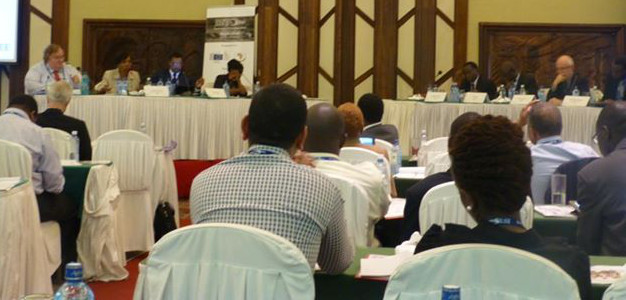Thomas Kunze and I are currently attending the IST Africa 2013 meeting, Nairobi based in the Safari Park Hotel on the outskirts of the city. The meeting brings together more than 400 people from around Africa and Europe who have an interest in the developing ICT infrastructures in Africa and their use in business, education and science.
The opening plenary sessions have been followed by five parallel sessions: International Cooperation; Technology-enhanced learning; eGovernment; Environment Sustainability; Cloud Computing, and eAgriculture. I’ve been following the Technology-enhanced learning sessions which have shown me that even the major challenges of stable electricity supply, getting internet access at all and having a means to interact with the internet are manageable problems. The use of mobile phone technology, especially smart phones gives access where computers are few. Thomas and I have met and talked to many new people from Africa as far north as Egypt and as far south as South Africa. Not surprisingly there is a strong Kenyan showing at the meeting including governmental representatives and many senior academics. The topics covered have been fascinating, especially the living labs projects. However, the logistical problems of developing ICT training in areas where electricity can be a luxury and internet is just not there offer a challenge that seems to be one that many projects are rising to. The use of WiMAX equipment provides a route to deliver good internet speeds in small communities. An excellent talk by Sibukele (Spooky) Gumbo “E-skills training on communal, fixed infrastructure as an activator of personal use of mobile internet” gave a wonderful overview of what can be done.
The Friday morning sessions I’m attending are on the use of Open Access software and Digital Library resources. The important question ‘Who do you sue if someone hacks in to your open access software?’ came up. It would be good to know the answer  Question from session chair (Moses Rugutt, Ministry of Education, Science and Education, Kenya) – How do we convert the complex figures and analyses presented this morning into practical, and straightforward, policies to more ICT activity forward? Ritin Koria presented on connectivity and interaction among systems and users. He emphasised the need to understand where key weaknesses were in connectivity that limit the entire IT system. My talk opened the after coffee session on Friday 31st May and was the first I have attended where the chairman kept talks to time and managed the Q&A session. It was a very interesting discussion and I had the chance to talk to Margaret Ngwira of the UbuntuNet Alliance. IST-Africa Presentation on i4Life
Question from session chair (Moses Rugutt, Ministry of Education, Science and Education, Kenya) – How do we convert the complex figures and analyses presented this morning into practical, and straightforward, policies to more ICT activity forward? Ritin Koria presented on connectivity and interaction among systems and users. He emphasised the need to understand where key weaknesses were in connectivity that limit the entire IT system. My talk opened the after coffee session on Friday 31st May and was the first I have attended where the chairman kept talks to time and managed the Q&A session. It was a very interesting discussion and I had the chance to talk to Margaret Ngwira of the UbuntuNet Alliance. IST-Africa Presentation on i4Life

A healthy coffee bush showing the ripe berries that contain green coffee beans. The hotel compound includes an agricultural area growing sugar cane, cassava, plantain, cabbage, lettuce, taro and several other crops.
Alongside the meeting and networking sessions I’ve been taking the opportunity to get images of plants and animals for my lectures. The hotel grounds are extensive, fenced and guarded. In the grounds is a selection of tropical trees and a vegetable garden area including coffee (Pictured here), cassava, plantain, chilli, sugar cane, taro, lettuce, cabbage and rosemary.
The tree flora is a mixture of species commonly planted around the tropics including Ceiba pentandra, a range of legumes, a sausage tree (Kigelia sp.), some palms, Encephalartos sp., and Ravanala madagascariensis.
For more information on the conference see the web site: IST Africa 2013
Tomorrow (Friday 31st May) I have my presentation on the i4Life project in session 10c Digital Libraries.
